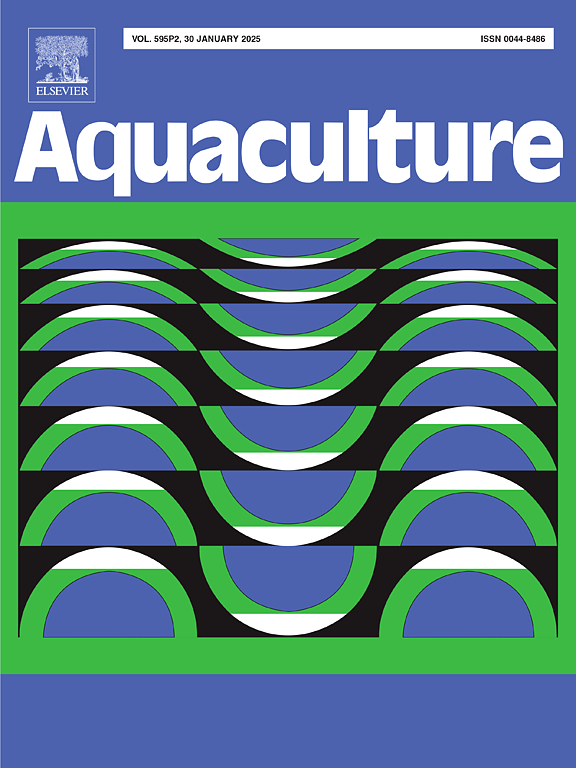焦性没食子酸治疗美国牛蛙多重耐药肺炎克雷伯菌感染的分子机制及治疗应用
IF 3.9
1区 农林科学
Q1 FISHERIES
引用次数: 0
摘要
耐多药肺炎克雷伯菌(MDR-KP)被世界卫生组织列为迫切需要新型抗生素的重大公共卫生威胁,并对牛蛙水产养殖造成了重大损失。目前缺乏对受感染牛蛙的有效治疗方案。本研究通过对MDR-KP的抗菌活性筛选鉴定了焦性没食子酸(PA),并对其机制进行了研究。体外实验显示,PA对牛粪源MDR-KP菌株(NW202109)的抑菌活性呈浓度依赖性,最低抑菌浓度(MIC)和最低杀菌浓度(MBC)均为320 μg/mL,在18 h内减少计数≥3 log。分子对接模拟预测PA与MDR-KP蛋白的关键残基(包括AcrB外排泵的丝氨酸135、OmpK36孔蛋白的天冬氨酸114)之间存在强相互作用。和ATPase的一个未识别残基(UNK276),每个残基都被三个氢键稳定,表明有多靶点抑制潜力。进一步的分析证实,MIC下4小时PA处理显著增加细胞内活性氧(ROS)和丙二醛(MDA)水平(P <;0.0001),降低了75.5%的ATP含量,抑制了生物膜的形成(P <;0.01)。在体内,PA (320 μg/mL,持续72 h)可减轻感染牛蛙肝脏、脾脏和肾脏的病理损伤,减少细菌负荷2.74 ~ 5.96 log10 CFU/g,降低促炎细胞因子水平。安全性评估显示,治疗剂量对血液或肝脏参数无不良影响。这些发现为PA通过多靶点机制对MDR-KP的疗效提供了初步证据,为其在水产养殖疾病控制和未来治疗开发中的应用奠定了基础。本文章由计算机程序翻译,如有差异,请以英文原文为准。
Molecular mechanisms and therapeutic application of pyrogallic acid in treating multidrug-resistant Klebsiella pneumoniae infections in American bullfrogs (Aquarana catesbeiana)
Multidrug-resistant Klebsiella pneumoniae (MDR-KP) is listed by the World Health Organization as a critical public-health threat urgently requiring novel antibiotics and has inflicted substantial losses on bullfrog aquaculture. Effective treatment options for infected bullfrogs are currently lacking. In this study, pyrogallic acid (PA) was identified via antibacterial activity screening against MDR-KP and subsequently investigated for its mechanistic effects. In vitro assays revealed concentration-dependent antibacterial activity of PA against a bullfrog-derived MDR-KP strain (NW202109), with both minimum inhibitory concentration (MIC) and minimum bactericidal concentration (MBC) determined as 320 μg/mL, reducing counts ≥ 3 log within 18 h. Molecular docking simulations predicted strong interactions between PA and key residues of MDR-KP proteins, including serine 135 of the AcrB efflux pump, aspartic acid 114 of the OmpK36 porin, and an unidentified residue (UNK276) of ATPase, each stabilized by three hydrogen bonds, suggesting multi-target inhibitory potential. Further analyses confirmed that 4-h PA treatment at MIC significantly increased intracellular reactive oxygen species (ROS) and malondialdehyde (MDA) levels (P < 0.0001), reduced ATP content by 75.5 %, and inhibited biofilm formation (P < 0.01). In vivo, PA administration (320 μg/mL for 72 h) alleviated pathological damage in the liver, spleen, and kidneys of infected bullfrogs, reduced bacterial loads by 2.74–5.96 log10 CFU/g, and lowered pro-inflammatory cytokine levels. Safety assessments indicated no adverse effects on hematological or hepatic parameters at therapeutic doses.These findings provide preliminary evidence for PA's efficacy against MDR-KP through multi-target mechanisms, establishing a foundation for its application in aquaculture disease control and future therapeutic development.
求助全文
通过发布文献求助,成功后即可免费获取论文全文。
去求助
来源期刊

Aquaculture
农林科学-海洋与淡水生物学
CiteScore
8.60
自引率
17.80%
发文量
1246
审稿时长
56 days
期刊介绍:
Aquaculture is an international journal for the exploration, improvement and management of all freshwater and marine food resources. It publishes novel and innovative research of world-wide interest on farming of aquatic organisms, which includes finfish, mollusks, crustaceans and aquatic plants for human consumption. Research on ornamentals is not a focus of the Journal. Aquaculture only publishes papers with a clear relevance to improving aquaculture practices or a potential application.
 求助内容:
求助内容: 应助结果提醒方式:
应助结果提醒方式:


